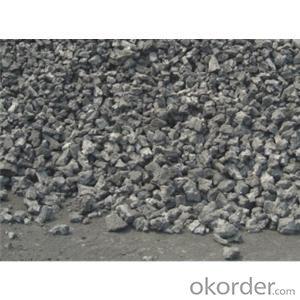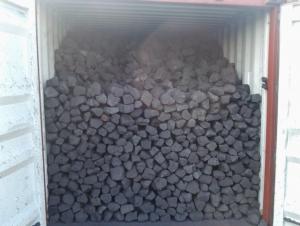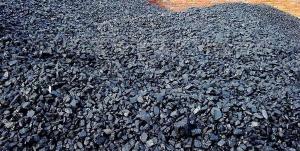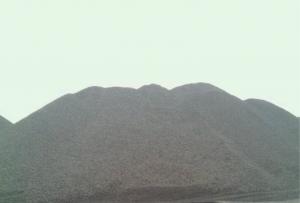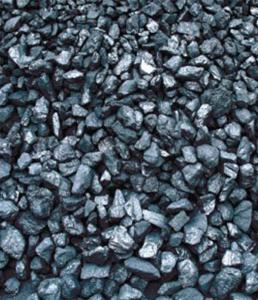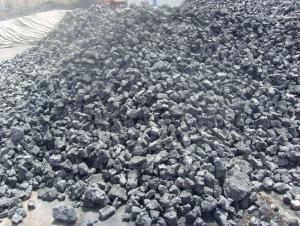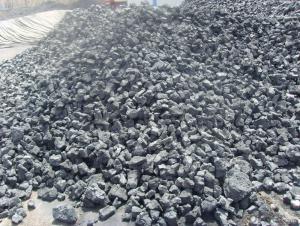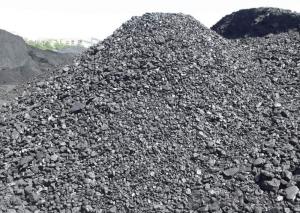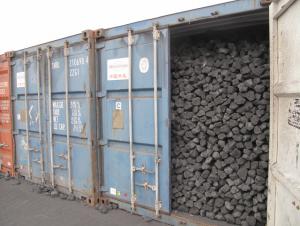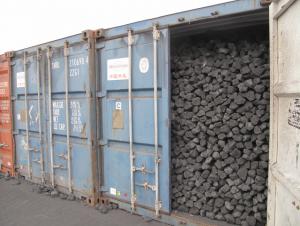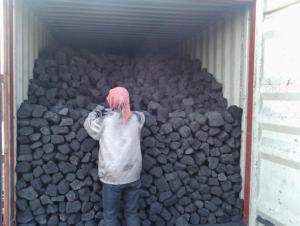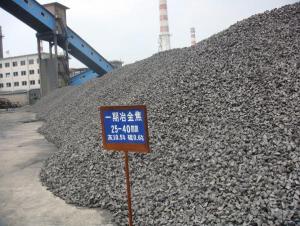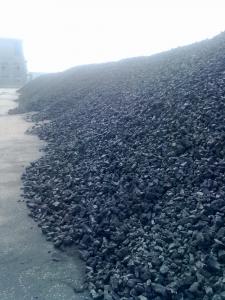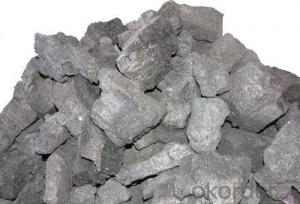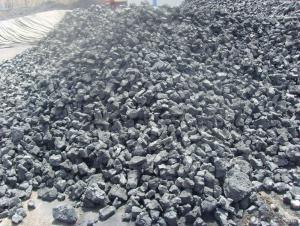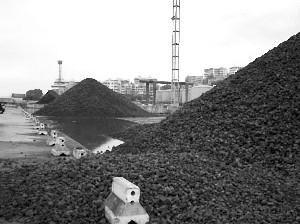Metallurgical Coke of size is 30 -- 90 mm
- Loading Port:
- Tianjin
- Payment Terms:
- TT OR LC
- Min Order Qty:
- 100 m.t.
- Supply Capability:
- 3000 m.t./month
OKorder Service Pledge
OKorder Financial Service
You Might Also Like
1. Structure of Metallurgical Coke of size is 30 -- 90 mm Description:
Coke is made by high temperature metallurgical coke for blast furnace smelting, casting and gasification. Occurring in the process of coking after recovery and purification of coke oven gas is a high calorific value of fuel, is an important industrial raw material in organic synthesis.
Coke is a hard texture, with carbon as the main component of irregular porous body, with cracks and defects in silver. The true density is 1.8 ~ 1.95 g/cm3, bulk density is 400 ~ 500 kg/m3, the porosity of 35% ~ 35%,.Coke all vertical and horizontal crack can be seen with the naked eye observation. The vertical and horizontal crack along the thick break, still is focal piece containing micro cracks.
To ensure the quality of coke, the choice is the most basic requirements of coking coal volatile matter, caking and coking properties; the vast majority of coking coal must go through washing, as much as possible to ensure low ash content, sulfur content and phosphorus content. When choosing a coking coal, but also must pay attention to the inflation pressure in the process of coal in coking. With low volatile coal coking, due to its colloid viscosity big, prone to high inflation pressure, harms the coke oven masonry, needs to be addressed by coal blending coking.
2. Main Features of the Metallurgical Coke of size is 30 -- 90 mm:
• Preferential price
• Various choice
3. Metallurgical Coke of size is 30 -- 90 mm Images:


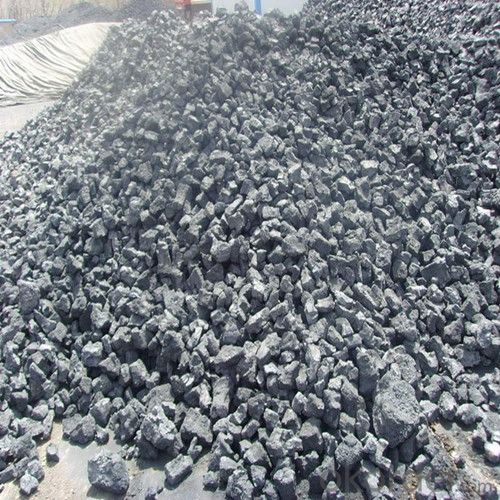

4. Metallurgical Coke of size is 30 -- 90 mm Specification:
Parameters | Guarantee | Rejection |
Total Moisture (As received basis) | 5% max | |
Ash (dry basis) | 12.5% max | > 13.5% |
Volatile Matter (dry basis) | 1.5% max | > 1.8% |
Sulphur (dry basis) | 0.65% max | > 0.75% |
Phosphorus (dry basis) | 0.035% max | > 0.045% |
M10 | 7% max | > 9% |
M40 | 84% min | <82% |
CSR | 64% min | <62% |
CRI | 26% max | > 28% |
Size 30-90 mm | 90% min | |
+90 mm | 5% max | > 8% |
-30mm | 5% max | > 8% |
5. FAQ
We have organized several common questions for our clients,may help you sincerely:
1) How to guarantee the quality of the products?
We have established the international advanced quality management system,every link from raw material to final product we have strict quality test;We resolutely put an end to unqualified products flowing into the market. At the same time, we will provide necessary follow-up service assurance.
2) What are coke's main physical properties?
on the relative density of density, coke, coke porosity, thermal conductivity for the heat capacity of coke, coke, coke, coke ignition temperature, coke thermal expansion coefficient of thermal stress and coke, coke shrinkage rate, coke resistivity permeability, etc.
The average heat capacity is 0.808 kj/(KGK) (100 ℃), 1.465 kj/(KGK) (1000 ℃)
Thermal conductivity is 2.64 kj/(MHK) (room temperature), 6.91 kj/(MHK) (900 ℃);
Ignition temperature (air) is 450-650 ℃.
3) How about your company?
Our company began to export coke when China cancelled 40% of coke export tariffs and quotas on January 1, 2013. We export many kinds of coke, such as CSR60 % and CSR 62% metallurgical coke (met coke), the NUT coke of 20 to 50 mm, coke breeze of 3 to 6 mm, and so on.
4)Main type
Metallurgical coke is blast furnace coke, coke, iron alloy and nonferrous metal smelting with coke. As more than 90% of the metallurgical coke for blast furnace ironmaking, so often called the blast furnace coke metallurgical coke.
Foundry coke is dedicated to cupola molten iron. Coke is the main fuel of cupola molten iron. Its role is hot metal melting furnace charge and overheating, support stock column maintain its good air permeability. As a result, coke blocks should have large, low reactivity, low porosity, with sufficient impact crushing strength, ash content and low sulfur content.
5) Application of coke
• Used for blast furnace ironmaking and used for copper, lead, zinc, titanium, antimony, mercury
• Other non-ferrous metal smelting of blast furnace,
• Reducing agent, compound
• The function of stock column frame.
6) The history of coke
Our country's metallurgical industry has a long history, is the original fuel charcoal smelting industry, due to the charcoal burning temperature is lower, and short duration of fire and not easy to master hour, therefore, directly affect the level of smelting, to make the steel quality is not guaranteed. Later, people use coal as smelting, coal combustion temperature is higher, and the combustion duration is longer than charcoal, but easily broken after coal is heated in the oven, affect the burden of permeability, and high content of sulfur in coal, directly affect the quality of the cast iron. After a period of practice, it has been found that the coal after dry distillation (i.e., separated flame heating), volatile components may be removed, and the porosity increased, resembling charcoal, fire is better than that of coal, but also can avoid charcoal and coal. This after carbonization of coal is coke.
Currently found in the earliest coke in our country, is in Guangdong new will be a unearthed in the ancient ruins in the late 13th century, during the southern song dynasty period in our country. Thus concluded that China's song dynasty, have been used to coke ironmaking. Guangdong new will find coke is also found that the earliest in the world. In Europe, the UK in 1788 began with coke ironmaking, this is the earliest record of western countries, the more than 500 years later than our country.
Although the use of coke earliest in our country, but has not seen through the records. Coking and the earliest recorded with coke can be found in the late Ming dynasty in China side to write the physical knowledge, he pointed out that coal everywhere all have, "smelly burning-out and closed into stone, chisel and charging again yue reef (coke), May 5, fire, cook Fried mine stone, will save Labour". This smelly coal, it is to point to contain volatiles more coking coal, the coal sealed burning-out, becomes hard coke, used for smelting, the effect is very good.
- Q:What is the difference between the industrial analysis of coke and the industrial analysis of coal samples
- There are also ISO and ASTM, I do not know what you want the standard?
- Q:Purpose of using coke in iron making raw materials
- The coke can provide the heat required for the reaction and has the reducibility
- Q:What is the difference between coking coal and coke
- Coking coal is the raw material for producing cokeCoking coal is produced by carbonization: coal gas (carbon monoxide), coal tar, coke
- Q:Mechanism of carbon and coke is not the same as the price which high?
- I am on the Ba Chau facility in Hebei during May this year, but now has more than 3 months, only 2 tons of carbon, and are defective pile to nobody in my barn. I bought a big machine, according to them is made of bark can make the raw material drying, but home. It's not going to work. I had to switch to coal drying, coal can not over drying, rework is often the case. Carefully down a do tons of carbon coal money to spend more than and 300. The great machine can not work normally, the basic propeller around 4 hours repair time, until now I have changed my sleeve 7
- Q:Coke indicators are divided into grades
- Coke is a solid product of high temperature carbonization, the main component is carbon, is a crack and irregular pore structure (or porous). The number of cracks has a direct impact on the strength and crushing strength of the coke, the index is generally measured in terms of crack degree (the number of cracks in the unit volume coke).
- Q:What are the requirements for the quality of coke in blast furnace smelting
- Evaluation of coke quality1, sulfur content in coke: sulfur is a harmful impurity of iron smelting, which reduce the quality of pig iron. The sulfur content in the pig iron is more than 0.07%. 11% of the sulfur from the blast furnace charge into the furnace comes from the ore, and the other comes from the limestone; the other is from the coke, so the coke is the main source of sulfur in the charge of the 82.5% of the charge. Sulfur content in coke directly affects the production of blast furnace. When the sulfur content in coke is greater than 1.6%, sulfur increased 0.1%, the amount of coke increased 1.8%, limestone amount increased 3.7%, 0.3% increase in amount of ore blast furnace output to reduce the sulfur content under 1.5 - 2.0%. metallurgical coke is not greater than 1%, the use of large and medium-sized metallurgical coke content in blast furnace is less than 0.4 - 0.7%.2, the phosphorus in the coke: iron metallurgical coke coke content should be in the following 0.02 - 0.03%.3, the ash content of coke: Coke Ash on the impact of the blast furnace smelting is very significant. Coke ash increased by 1%, coke consumption increased by 2 - 2.5%, therefore, the reduction of coke ash is very necessary.
- Q:Used in a restaurant?Dry or dry carbon carbon, coke or coke, and I do not know which word is a word of this sound. The use of coke for iron making. They are more than 1000 yuan price.The main problem is: dry carbon is coke?Toxic smoke, then the chimney can not do? Can I use the blower?
- Dry carbon is not coke, but the combustion will produce a lot of harmful substances, it is recommended to install a more advanced cleaning device. Thank you
- Q:What are the uses of these early industrial iron and steel? Any difference?What kind of carbon do we eat in the middle of a long strip of carbon?
- Coke:The utility model is mainly used for blast furnace ironmaking and smelting of blast furnace for non-ferrous metals such as copper, lead, zinc, titanium, antimony, mercury, etc.. The use of coke instead of charcoal in the blast furnace has laid the foundation for the large-scale development of modern blast furnaces and is a major milestone in the history of metallurgy. In order to achieve better technical and economic indexes of blast furnace operation, the coke (metallurgical coke) must have proper chemical and physical properties. In addition to a large number of coke used in iron smelting and non-ferrous metal smelting (metallurgical coke), but also for casting, chemical, calcium carbide and iron alloy, the quality requirements are different. Such as foundry coke, generally require large size, low porosity, high fixed carbon and low sulfur; chemical gasification, strict requirements for strength, but requires good response, high ash melting point; calcium carbide and coke production requirements to improve the fixed carbon content.
- Q:Why does Coke provide heat when it is fired, it reacts only at high temperatures and why it is needed to provide heat?Which is the exothermic reaction, carbon dioxide or carbon monoxide?
- Yes;To restore the Fe reaction to provide heat, this reaction requires a higher heat, but the heat is high, the heat is not high enough to provide; so adding coke, more convenient to raise the temperature;
- Q:Coke and coal is one thing
- Coke is bituminous coal under the condition of isolated air, heated to 950-1050 DEG C, after drying, pyrolysis, melting, bonding, solidification, shrinkage and other stages of the final coke, this process is called high temperature coking (high temperature carbonization).Coke is a deep processing of coal products.
1. Manufacturer Overview |
|
|---|---|
| Location | |
| Year Established | |
| Annual Output Value | |
| Main Markets | |
| Company Certifications | |
2. Manufacturer Certificates |
|
|---|---|
| a) Certification Name | |
| Range | |
| Reference | |
| Validity Period | |
3. Manufacturer Capability |
|
|---|---|
| a)Trade Capacity | |
| Nearest Port | |
| Export Percentage | |
| No.of Employees in Trade Department | |
| Language Spoken: | |
| b)Factory Information | |
| Factory Size: | |
| No. of Production Lines | |
| Contract Manufacturing | |
| Product Price Range | |
Send your message to us
Metallurgical Coke of size is 30 -- 90 mm
- Loading Port:
- Tianjin
- Payment Terms:
- TT OR LC
- Min Order Qty:
- 100 m.t.
- Supply Capability:
- 3000 m.t./month
OKorder Service Pledge
OKorder Financial Service
Similar products
New products
Hot products
